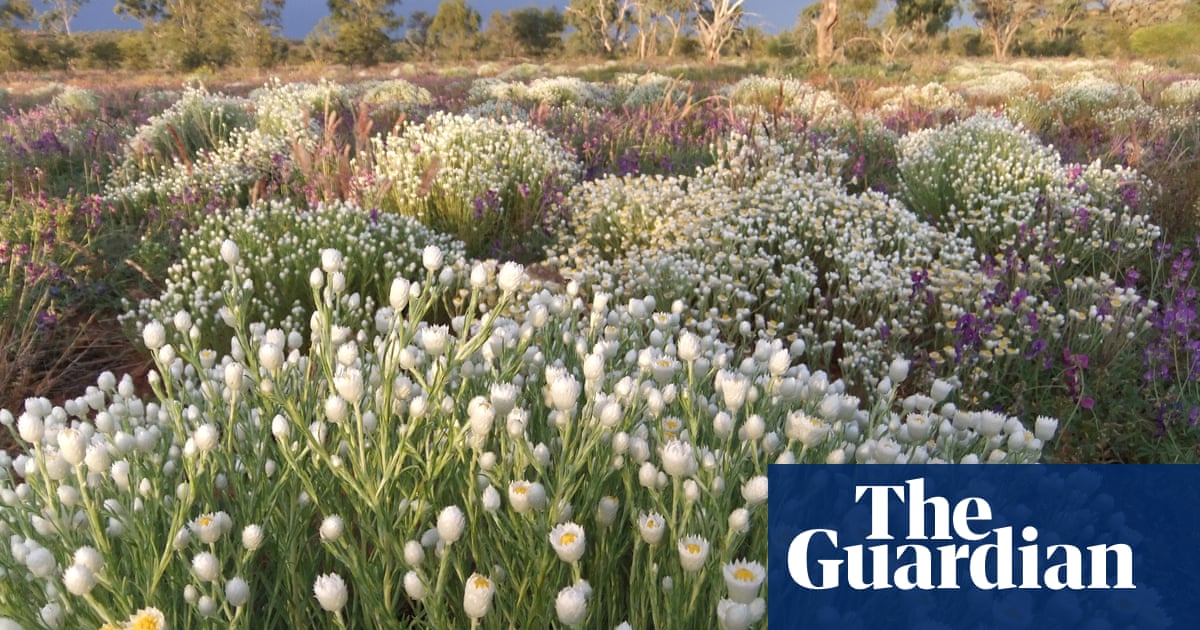While a few Guardian Australia readers told us their own back yards are the best spots in the country to watch wildflowers bloom, many recommended places a little farther afield.
Queensland
Two readers recommended south-east Queensland’s Girraween national park in the granite belt region for its “spectacular wildflower displays” in spring. Both praised the area’s “great diversity” of plant life – with close to 1,000 species found in the area.
“At up to 1,000 metres to the north of the New England Tableland and on top of the Great Divide between the coast and the western slopes, the area is on the edge of many habitat, climactic and geographic regions,” one reader writes.
Liz Bourne, secretary of the Stanthorpe Rare Wildflower Consortium, adds that there are magnificent views from the granite peaks and good swimming in the park’s creeks.
Winton
At the Australian Age of Dinosaurs Museum in central Queensland, reader Colleen writes heavy rains bring “a gorgeous, vast sea of yellow and purple” blooms: “The expansive view from the top of the plateau made the flowers look like a … carpet of colours.” The floral displays make it easy to imagine the inland sea that once covered the area, she writes, while “the museum itself is fantastic”.
New South Wales and Australian Capital Territory
Broken Hill and Silverton region
“In spring the desert blooms in all shades of pinks, reds, yellows and purple,” writes reader Sue Pepper of the Broken Hill and Silverton region. “For a short few weeks you realise that the desert is truly alive.”
“The flowers are set off magnificently by the red soils of the ancient land.”
Pepper also recommends visitors drop in on the Living Desert Reserve and sculpture garden while in the area.
Parliament House Gardens, ACT
Cormac Farrell writes that there are almost 30ha of gardens, featuring plants from all over the country, in the gardens surrounding Parliament House, “creating this beautiful, ever-changing kaleidoscope of colour along the walking trails”.
He admits he has a personal bias: “As head beekeeper for parliament, the gardens are not just beautiful but also functional – feeding the bees I care for. The honey from the hives also constantly changes, as different flowers bloom in different ratios year to year.”
Sculptures in the Scrub walking track, Pilliga
Guardian reader Gordon Deans writes that Timmallallie national park’s Sculptures in the Scrub walk is worth visiting any time of year, but in spring, “wildflowers line the path with a profusion of different species”. The views along the rim of Dandry Gorge, the sculptures and the wildflowers combine to make this spot in the Pilliga, “a truly magical experience”. Nearby, Deans also recommends the Pilliga Forest Discovery centre, the Pilliga lookout tower and the Salt Caves picnic area.
Warialda
The sandstone forest surrounding the town of Warialda in the New England region of northern NSW has a wide variety of flowering shrubs, grass trees and delicate white flannel flowers. Guardian reader David Carr recommends Cranky Rock nature reserve, just on the edge of town as the place to start looking.
A drive through the Warialda national park via Delungra to Bingara, will take you past the Myall Creek Massacre memorial site, a national heritage place created in memory of the Wirrayaraay people.
Victoria
Whipstick nature conservation reserve, near Bendigo
In mid-to late August, the Whirrakee wattle begins to bloom in the areas surrounding Bendigo. Guardian reader Neil recommends viewing it in the Whipstick forest, writing: “This wattle is found in just one small area of forest, but in that small area, its blossom creates hillsides of vivid yellow.”
He recommends the picnic area and walking track nearby at Shadbolts, and suggests those wanting to explore the area more fully pick up a copy of Take a Forest Walk, a local bushwalking guide put together by the Australian Conservation Foundation, and available at the Bendigo Visitor Information Centre.
Heatherlie Quarry, Grampians (Gariwerd) national park
Guardian reader Russell Kealey writes that he loves the peace of this old bluestone quarry, that once supplied the stone for Melbourne’s GPO, town hall and state library. “In contrast to the noise when it was operating!”
after newsletter promotion
“The range of wildflowers is wonderful; native orchids, grevilleas, leptospermum and many others I didn’t know.”
Kealey recommends the nearby town of Halls Gap for lunch or coffee, and adds that in the Grampians, “you are spoilt for choice with amazing lookouts all over”.
South Australia
Hale conservation park, near Williamstown
In addition to beautiful native orchids, you can expect to spot echidnas and lovely valley views on the 4km loop trail around Hale conservation park, writes Guardian reader Jane. “I just love Hale conservation park in the springtime.” She recommends stopping for coffee in nearby Williamstown before or after your walk.
Janet Drummond writes there is “so much to do” in Innamincka reserve, a remote desert spot in the north-east, near South Australia’s border with Queensland. “After watching flowers all day you can sit and watch the milky way at night.”
The area has “the most remarkable wildflowers on a red sandy ground: yellows, purples and whites,” Drummond writes. She loves everything about the place, especially “the change from the harsh desert environment to a remarkable flowing oasis for acres and acres all around”.
Note: Many areas of Innamincka Regional Reserve are currently closed due to flooding.
Western Australia
Guardian reader John writes that Kings Park and Botanic Garden, right near the centre of Perth is, “picturesque by any standard”.
“There is an amazing profusion of Australian native flowers, over almost 1,000 acres that then overlooks the city of Perth and the Swan River.” John writes that the variety of flowers – including kangaroo paws and callistemon (bottlebrushes) is fantastic, but his personal favourite is the Banksia coccinea. “The best I have ever seen have been in this botanical garden.”
Guardian reader John warns that while Lesueur national park on Western Australia’s coral coast is astonishing, it is also very remote – at least 50km from the nearest town. Bring your own food and drink, adequate water and a hat, he writes.
The preparation and long drive comes with a big reward: “Long walk trails take you past one different WA wildflower after another, hundreds of different species,” John writes. “Not in clumps, one after the other. Stuff you’ve never seen before.”
Fitzgerald River national park
Located between Albany and Esperance on the southernmost end of Western Australia, Fitzgerald River national park is one of the largest and most botanically diverse parks in the country, with 75 plants found only in the area. Guardian reader Carsten Wagner-Richelmann loves the view over West Mount Barren, and writes that “as a bonus, there are southern right whales giving birth at Point Ann beach”.
Northern Territory
The two-hour drive between Titjikala and Finke Road, more than 100km south-east of Alice Springs, bursts into life after rain in April and May, writes Shrike O’Malley. “These red sandy areas are carpeted with yellow, white, pink and mauve flowers … various native daisies, pussy tails or Mulla Mullas, native peas and native stocks. The red sand provides an awesome backdrop to these canvases of floral colour.”
“After big rains these areas can become abuzz with native bees, butterflies and birds, including mobs of colourful budgies, cockatiels, woodswallows and chats – all attracted to the oodles of seed and insects these wildflower havens produce.”
Meanwhile, at night: “The scent for the various daisies and night-scented stocks, combined with the sifted wind sounds the desert oaks orchestrate, are the best remedy for sleeplessness!”









